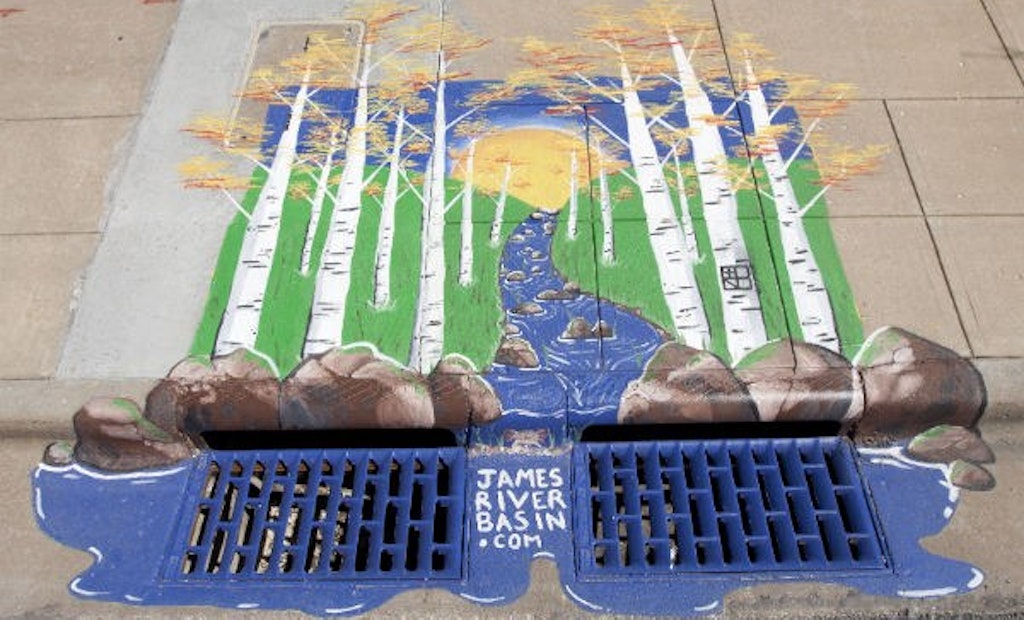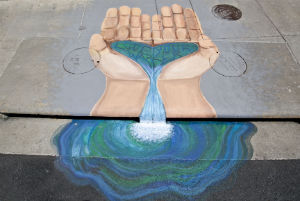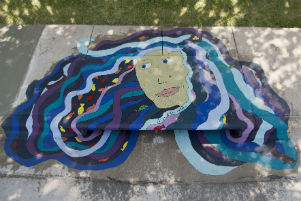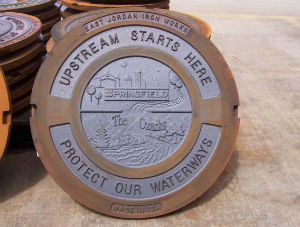
Interested in Stormwater?
Get Stormwater articles, news and videos right in your inbox! Sign up now.
Stormwater + Get AlertsPictures often speak louder than words in the Show Me State. That’s certainly the case in Springfield, Mo., where infrastructure is proudly put on display. Through the creative use of storm drains to convey stormwater themes and manhole covers as a more permanent reminder, keeping waterways free of runoff has become a work of art.
 Over the past four years, 38 artists have painted 40 storm drains with 8-by-8-foot murals displaying how soap, litter, grass clippings, fertilizer, pet waste, oil and other contaminants affect water quality. The annual event — known as Storm Water Reveal — serves the dual purpose of protecting the environment and educating the public on the inner workings of the city’s municipal stormwater system.
Over the past four years, 38 artists have painted 40 storm drains with 8-by-8-foot murals displaying how soap, litter, grass clippings, fertilizer, pet waste, oil and other contaminants affect water quality. The annual event — known as Storm Water Reveal — serves the dual purpose of protecting the environment and educating the public on the inner workings of the city’s municipal stormwater system.
A community project
This year, photos of the drains were voted on during First Friday Art Walk in May and displayed during Artfest on Historic Walnut Street several days later. The winning artist received $50. Photos are also displayed in coffee shops and restaurants, providing residents with a year-round runoff reminder.
 “Most people are surprised when I tell them that the storm drain leads directly to freshwater supplies instead of going to a treatment plant,” says Laura Lynch, a former People’s Choice award winner. “When they know about it they usually thank me for the effort. It’s gratifying to be able to help a program that positively impacts our environment.”
“Most people are surprised when I tell them that the storm drain leads directly to freshwater supplies instead of going to a treatment plant,” says Laura Lynch, a former People’s Choice award winner. “When they know about it they usually thank me for the effort. It’s gratifying to be able to help a program that positively impacts our environment.”
Storm Drain Reveal got its start in 2008 when a high school student asked if he could paint a mural on a storm drain. The undertaking was more public art than stormwater education, but the message soon got around. The following year, he painted another.
About this time, the James River Basin Partnership was looking to put a new spin on its Rain Barrel Reveal project where stormwater works of art were auctioned off as a fundraiser. In 2011, the city and non-profit organization combined efforts and Storm Drain Reveal was born.
Donations and local support fund the campaign that has inspired similar efforts in other parts of the state and Arkansas. It has also drawn interest from cities in Hawaii, Pennsylvania, Maryland and Florida.
Satisfying MS4 requirements
The project is part of Springfield’s ongoing stormwater education/outreach efforts, a requirement of the city’s Municipal Separate Storm Sewer System (MS4) permit as mandated by the Clean Water Act.
“Our education program started in 2002 when we got our MS4 permit,” says Carrie Lamb, water quality coordinator, Stormwater Quality Division, Department of Environmental Services for the City of Springfield.
“Like a lot of cities, we started out small, developing brochures, having educational displays at community events and doing storm drain marking.”
In 2007, the city created a storm drain manhole cover design contest as a more permanent and more visible way to bring the storm drain message home to residents.
 The winning design depicts the city of Springfield with water flowing downstream to the Ozarks encircled by the phrase “Upstream Starts Here” and “Protect Our Waterways.” The design and phrase have become standard for all new storm drain manhole covers in the city, with hundreds already installed.
The winning design depicts the city of Springfield with water flowing downstream to the Ozarks encircled by the phrase “Upstream Starts Here” and “Protect Our Waterways.” The design and phrase have become standard for all new storm drain manhole covers in the city, with hundreds already installed.
Educational variety
The city also works with the Watershed Committee of the Ozarks, a non-profit organization that focuses on sustaining and improving water resources through education and effective watershed management.
“They do a lot of education with kids,” Lambs says. “They have a great watershed center in a public park. Kids take field trips out there. There’s a stream and a lake, so they do water quality sampling.”
Another way the city spreads its stormwater message is through interpretive signage in highly visible locations, explaining the purpose of such structures as rain gardens and pervious pavement.
“We have one that’s right outside the front door of one of our libraries,” Lamb says. “We have some along our trail system.”
Other outreach efforts include Stormwater 101, a Web-based mini lesson on how a drainage system works and why stormwater management is important. A complementary education campaign helps residents recognize signs of stormwater pollution and what they can do to prevent it through the responsible use of fertilizer, recycling household chemicals and recycling used motor oil. Residents also are encouraged to take an active role in stormwater management through the city’s Adopt-A-Stream Program and report storm drain pollution activity.
Lamb says an important benefit of the stormwater education/outreach programs has been an increased understanding among residents when asked for funding, as well as a reminder that not all water flows to the city’s two wastewater treatment plants — some drains to lakes and streams.





